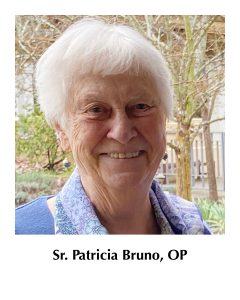- All
- Wisdom
- We Stand on Their Shoulders
- Vocation
- Uncategorized
- Stories Seldom Heard
- Spirituality
- Social Justice
- Prayer
- Peace
- Oneness
- Love
- Letting Go
- Lent
- Joy
- Inspirational Images
- Hope / Healing
- Holy Week
- Gratefulness
- God's Presence
- General News Stories
- Forgiveness
- Finding God
- Faith
- Easter
- Dominican Saints
- Discipleship
- Courage
- Christmas
- Catholic Sisters Week
- Care of the Earth
- Blessing
- Beauty
- Advent
- #justiceOPportunity
Synodality: A Story to be Heard and Lived
Sr. Patricia Bruno, OP

269th Edition December 2021
 Many of us are renewing our acquaintance with the word and practice of “synodality.” The process of synodality was first introduced to us in the early 1960s in preparation for the Second Vatican Council. For a while after the Council, we conscientiously took this practice to heart. Over the years, it slowly drifted from our vocabularies.
Many of us are renewing our acquaintance with the word and practice of “synodality.” The process of synodality was first introduced to us in the early 1960s in preparation for the Second Vatican Council. For a while after the Council, we conscientiously took this practice to heart. Over the years, it slowly drifted from our vocabularies.
However, on October 28, 2021, Pope Francis formally opened a two-year process called “A Synod on Synodality.” Synodality, is the experience of the people of God, the whole church, “walking together.” Rooted in the spirit of the Second Vatican Council, this process is one of deep listening to all members of the church so that together we will come to a fuller understanding of our church’s responsibility to serve and preach the Good News to our modern-day world.
Listening to one another is key to the process. St. Benedict in his Rule describes well this sincere and attentive listening. It is the “practice of listening with the ear of the heart (which) sets in motion a pathway to authentic discernment of the will of God” (Rule of St Benedict). Synodality is more than collecting opinions or running surveys. It is an invitation to foster organized conversations in every diocese throughout the world so that together we might better read the signs of the times and respond with justice, mercy, and compassion.
Even though many of us might associate a listening and discernment process with the Second Vatican Council, this specific type of conversation is not a modern invention. In fact, the practice draws insight and guidance from the first millennium of our Christian tradition.
Think of the synodal practice of St. Cyprian, bishop of Carthage: do nothing without the council — of presbyters and deacons — and the consensus of the people. The order is important: take advice from some and build consensus with all as people of God. Consensus presupposes a process of consultation, listening, dialogue, and discernment in a collaborative mode (1).
The process seeks to achieve some sensus ecclesiae (to feel with the entire church). It is not about limiting or eliminating the decision-making power of the pope or that of the bishops. In fact, it affirms that and strengthens it, demanding that their decisions emerge from sincere consultation and seeking consensus since every exercise of authority in the church is to be at the service of the people of God (2).
As I searched the Synod sites on the Internet, I saw many creative expressions of what Synodality means to a variety of lay and ordained ministers throughout the world. One of the cathedrals in the United Kingdom constructed the bow of a boat that reached out from the sanctuary of the church into the body of the church. As this community of faith officially began its commitment to the Synodality process, parishioners and clergy entered the bow space together. The caption beneath the photo stated, “We are all in the same boat.” During a Eucharistic celebration, one of the Austrian faith communities presented a huge, beautiful, multi-colored modern painting that expressed their faith in the active presence of the Holy Spirit as their community committed themselves to the Synod discernment process. There was a video and a succinct statement from Italy: “The aim is to create a wide space for listening and sharing among the participants, both in the classroom and online, thus implementing the synodal process and developing a truly synodal style in theology.”
From all over the world videos, photos, and creative projects continue arriving on the Internet. The postings express diverse cultural expressions of the innovative ways communities are approaching and committing themselves to the synod process (3). One of the countries of Latin America posted a drawing of a mother, father, and baby in arms walking down a road. They were easy to identify. Bethlehem was written in the background. In the foreground in large script was written, “Let us go down the road together.” Another community draws attention to their commitment with these words woven into a huge seamless cloth. “We are a cloth of different colors and types forming the same cloth: happy and diverse.”
As we approach this worldwide synod process, we are conscious of the other smaller synods that Pope Francis has held. The Synod on the Family, Youth, and the Amazonian Synod in the Pan-Amazon region. All of them were listening and discernment sessions. As we review these synods and listen to their reports we recognize once again how culture and regional needs affect the outcome of the discernment processes. An in-depth reflection on the history, as well as, an examination of the current issues in a particular geographic area are important components of the regional processes. The church is worldwide and the many diverse regions and cultures must listen carefully with, and to those involved. The conscious involvement and serious inclusion of every part of the world certainly reflect the history and heritage of Pope Francis. He, as we know, is the first Pope who is not from the Euro-Mediterranean region. His experiences influence his worldview and his concerns for the worldwide church that is to listen to and serve every region of the world.
In Pope Francis’ homily on October 10, 2021, in St Peter’s Basilica, he characterized the Synod as a time to encounter, listen and discern together.
Every encounter, as we know, requires openness, courage, and willingness to let ourselves be challenged by the presence and the stories of others….True encounters arise only from listening….Let us not soundproof our hearts; let us not be barricaded in our centuries….God’s word is ‘living and active, sharper than any two-edged sword, penetrating even between the soul and spirit, joints and marrow, and able to discern thoughts and intentions of the heart (Pope Francis’ Homily October 10, 2021).
There is much more to learn about the Synod. I have noted in the footnotes two excellent websites. Even though the process might just be starting in your diocese it’s important to be proactive and learn about it. I hope this article will encourage your participation. Your diocesan newspaper, pastor, and parish ministers will be looking for eager participants. Keep your eyes and ears open! See where you can contribute to this process in your own diocese. If you do not participate, your voice will not be heard.
As we begin this Advent season may we as our Latin American friends said, walk the road together for we are truly one seamless cloth. As we walk the road “Let us not soundproof our hearts.” Advent blessings.
Footnotes
- MA version of this story appeared in the Sept 3-16, 2021print issue in the National Catholic Reporter under the headline: Synodality’s promise for a more inclusive church. Using this title, the complete interview of Rafael Luciani by Hosffman Ospino can be found on the web. Rafael Luciani, a native of Venezuela, serves as a theological expert for the regional Latin American Episcopal Council (CELAM) and the Confederation of Latin American Religious (CLAR). Hosffman Ospino is a professor of theology at Boston College, where he chairs the Department of Religious Education and Pastoral Ministry. He has conducted several national studies on Hispanic Catholics.
- Ibid
- #ForASynodalChurch – Newsletter
